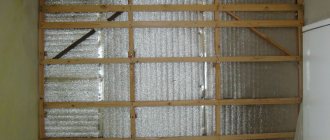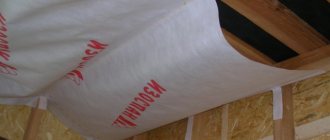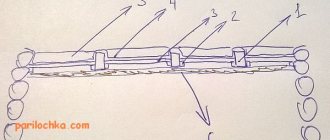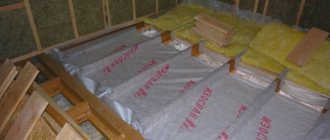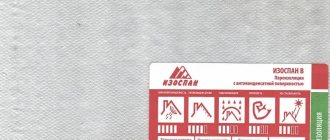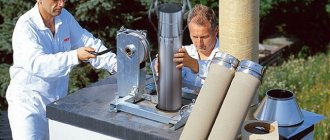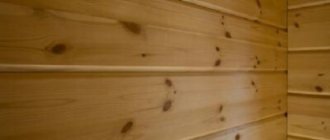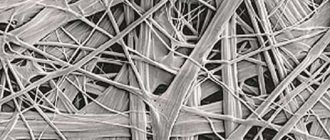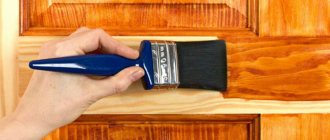Izospan is an insulating film coating. The main purpose of the film is to ensure that the original thermal insulation characteristics are maintained throughout its entire service life. It is difficult to imagine a modern construction project without the use of various types of thermal insulation. Mineral wool, Penoplex, Izolon, Izover, various polystyrene foams and simply polystyrene foam - all these materials require their own protection.
Thermal insulation materials practically envelop our house, retain heat on frosty and rainy days, create comfort in the hot summer, preventing the penetration of heat flows. But how to protect the thermal insulation belt from negative atmospheric phenomena? Reliable protection from moisture, rain, damaging winds is designed to be provided by 100% polypropylene, with the proud name - Izospan .
To create a barrier at the stages of the construction process, to perform the function of protective insulation for thermal insulation, this is the true purpose that isospan vapor barrier successfully fulfills. Despite its apparent simplicity, the material differs by type.
We bring to your attention – Izospan instructions for use. Figure it out: which side to lay the isospan on. Consider the isospan technical characteristics, and the installation method.
Worthy competitors of isospan:
- Tyvek vapor barrier;
- Vapor barrier TechnoNIKOL;
- Vapor barrier Nanoizol;
- Vapor barrier Ondutis;
- Vapor barrier Yutafol.
Before moving on to a detailed review, it should be clarified that the films are presented by the manufacturer in a wide variety and have different purposes. Vapor barrier films and membranes are divided into absolutely vapor- and water-tight and partially permeable to moisture only in one direction. Some of the materials successfully complement thermal insulation, enhancing its characteristics.
Characteristics and differences
Izospan is a non-woven building material. It is produced in the form of films and membranes, which are designed to protect and insulate surfaces. Izospan goes on sale in rolls.
Materials are divided into three groups:
- Windproof. This includes all insulators marked with the letter A. They are needed to retain internal heat and prevent winds from blowing through the insulation. The material does not allow moisture to pass through, but is capable of removing evaporation.
- Fully waterproofing. They are marked with the letters B, C, D. And they do not allow water or evaporation to pass through.
- Energy saving. They are marked with the letter F. They have the same characteristics as the previous group, but have a metallized reflective layer.
From the above it can be understood that only the first group has the ability to pass steam. It is precisely this that should be used to insulate residential premises, since all living organisms emit fumes into the atmosphere. And if the liquid in the form of steam is not able to leave the room, then the humidity in it will soon rise critically.
Types of vapor barrier Source stroychik.ru
The remaining groups are solid insulators. But the latter has a thin metal coating that can reflect heat, preventing it from leaving the room. This feature requires an air gap between the mirror layer and the other material. It must be at least 3.5 cm.
And before you think about how to properly lay Izospan, you need to fully study the brand on the product. The first letter on the marking is often followed by others. They indicate additional insulation properties. For example, the letters M or S indicate the presence of reinforcement. And the abbreviation of small letters “fix” indicates the presence of applied strips of glue along the edges. And when buying such a product, you don’t have to worry about tape.
Product range overview
Varieties of Izospan A differ in strength and structure.
Each group of materials includes modifications with different structures. The mechanism of action of all membranes of one group is the same, but the structure and properties are different.
The Izospan A line includes:
- A - its vapor permeability is maximum at a higher density - 110 g/sq. m. When laying it, be sure to leave a gap for ventilation.
- AM is a three-layer membrane. It is installed without a ventilation gap: air passes between the layers of the vapor barrier and removes moisture.
- AS - has the same properties as the previous modification, but is denser - 115 g/sq.m. m.
- AQproff is a vapor barrier with a three-layer structure and reinforced reinforcement. Designed for external work. It is also used as temporary protection of a wall or roof while the main finishing is missing.
- A with OZD – fire-resistant vapor barrier. A non-combustible membrane is installed when insulating ventilation facades. Also, A with OZD is used during welding work to protect insulated structures located near the work area.
Izospan B and C are types of vapor barrier with anti-condensation film. Their purpose is the same and they differ only in strength.
Izospan A
The material is produced in the form of a diffusion membrane, which is capable of completely retaining any liquid. But evaporation passes through it easily. Therefore, if it is positioned correctly, it serves as reinforcement and protection of thermal insulation. It also does not allow the latter to accumulate moisture from evaporation coming from the room.
Vapor barrier marked A Source roofing façade34.rf
The exception is Izospan A (base). This material serves only as a wind barrier and, in addition to steam, it also allows moisture to pass through. It is used to insulate the ceiling located above the facade, in which there is good air circulation. Place the membrane on top of the mineral wool, on the subfloor side. And it allows the insulation to get rid of not only steam, but also water.
The temperature range for operating the material is quite wide. The insulator can be used from severe frosts of -60 °C to serious heat of +80 °C. Izospan A is able to retain its characteristics even when exposed to ultraviolet radiation. But the truth is only for 3-4 months. Then a sharp decline in performance begins.
The insulator is able to withstand a fairly large tensile load, and some materials even have fire-fighting properties. Based on these parameters, group with the letter A is best used for ventilated facades and frame-type enclosing structures. Also for a roof that has double sheathing and a slope of at least 35 degrees.
Waterproofing for metal tiles Source stoydiz.ru
See also: Catalog of companies that specialize in home insulation
Basic rules for working and instructions on which side to lay Izospan A to the insulation:
- The material on the wall begins to be mounted from below.
- The same sequence must be maintained when working on a pitched roof.
- On horizontal roofs, Izospan is laid starting from any of the walls.
- The next panel must be laid with an overlap on the previous one. Ten centimeters are enough on the walls, and ceilings and roofs should have at least fifteen centimeters.
- If there are no adhesive strips on the edges, then all connections are fixed using double-sided tape.
- For a clearer connection to the rafter system, it is better to use a special sealing tape.
- For material with clear markings (only one letter A), it makes no difference which side the insulator is applied to the insulation.
- Izospan, which has double markings (AS, AM and others), must be unfolded so that the logo is on the outside.
Installation of vapor barrier Source dolgostroi.pro
The last point is very important. If you make a mistake, fumes will begin to accumulate in the insulation. It will get wet, which will lead to the loss of its positive properties. The process will speed up significantly when moisture begins to partially penetrate from the outside as the other side allows steam to pass through. And there is enough vapor everywhere.
Installation plan
Installation of Izospan B has features depending on which element of the structure needs to be protected.
For attics and attic floors
The installation diagram is shown in Figure 1.
First you need to unroll the roll and cut the ribbons to size. To determine which size of panels is most convenient and economical for installation, it is necessary to measure and mark the walls and ceilings. Then you need to apply the first tape to the internal insulation of the attic or attic (from the ceiling side) with the smooth side and secure it.
The fastening method is chosen which is more convenient for the owner: it can be fastened with a construction stapler or on nails. The first tape in attics must be laid from below, parallel to the floor. For convenience, the tapes can be rolled into tubes with the desired side inward and unfolded as they are secured.
Next, you need to secure the following tapes in the same way, overlapping the previous one with an overlap of about 15 cm. Seal the joints with a special tape such as Izospan KL, KL+ and mount the lathing for cladding or finishing material on the coating. For ventilation and evaporation of possible condensation, the gap between Izospan B and the cladding should be 50 mm.
For interfloor ceilings
The installation diagram is shown in Figure 2:
Installation proceeds as follows:
- Unroll the roll and cut the ribbons to size;
- secure the first tape with the rough side to the rough ceiling (floor) using a stapler or nails;
- fasten the remaining tapes parallel to the first, with an overlap of 150 mm;
- seal the joints for sealing with the appropriate tape of the Izospan family;
- install the sheathing and lay insulation.
Next, you will need to lay another layer of Izospan B with the smooth side facing the insulation, secure it to the sheathing and seal the joints.
On top of the insulation, it is necessary to provide a ventilation air gap (gap) of 50 mm using counter slats on which the finishing cladding can be installed.
Izospan B
Unlike the previous material with a mark in the form of the letter A, all other markings are vapor barriers. And since they do not allow evaporation to pass through, they completely protect the insulation from moisture. Therefore, Izospan is placed in front of the insulation, and not behind it, as in the previous case. This is if you look at it from the room. They are produced in the form of film, and it is usually two-layer.
Izospan marked B, consisting of polypropylene, is used to strengthen the ceiling insulation and protect it from moisture. The material has the same temperature range for use as Izospan A. The characteristics of water resistance and ultraviolet resistance are also the same.
In order to understand how to properly lay Izospan with such markings, you need to carefully examine the sides of the material. One of them is perfectly smooth. On the other there are the smallest fibers. So they do not allow moisture to accumulate on the walls.
Izospan B Source opotolkax.com
The lint on the surface helps water roll down quickly. Therefore, the smooth side of the material should be adjacent directly to the insulation, without any gaps. The latter is necessary before a rough surface. Otherwise, moisture will not be able to move down.
How to protect your home from excess moisture?
There are several ways to protect your home from the harmful effects of water vapor. Firstly, ensuring good ventilation, in which moist indoor air will be constantly released into the street, and fresh, drier air will begin to replace it.
Secondly, the use of water- and vapor-tight barriers that do not allow moisture to pass through, but allow it to slowly evaporate.
With this method of protection, water does not get into the insulation and onto the walls, and the resulting condensate evaporates directly from the protective coating.
Izospan C, D
Marking C indicates that the material is well suited for insulating insulation under the roof. It is often used instead of a waterproofing substrate under metal tiles. It is also laid when arranging concrete floors in places where humidity exceeds specified standards.
Marking D indicates that the insulator has good UV resistance. This circumstance and the fact that the material has greater strength allows it to be used as a temporary roof. Otherwise, it is used like the previous insulator.
There is no need to guess which side to lay the Izospan with these markings on. The materials also have a rough surface on one side. So she should look into the room. And the smooth side must be adjacent to the insulation.
Stages of vapor barrier installation Source krepezhinfo.ru
What is the canvas? ↑
izospana-b-1 izospana-b-2
If we compare Izospan with other cheaper analogues of vapor barriers, it is made not from polyethylene, but from 100% polypropylene. In addition, the material of the panel itself is reinforced and has two layers - smooth (rear) and rough (external).
This structure gives all the advantages: high strength and stability, the ability to remove moisture from the surface, close contact with the insulation.
In the production of Izospan, they adhere to the technology of melting the initial raw materials, followed by rolling and rolling on rollers, forming the residual thickness of the web and its structure.
But, such material has one drawback - its cost is higher in comparison with polyethylene analogues. However, high-quality vapor barrier coatings are well worth their price.
Note It is also worth knowing that although the film contains ultraviolet stabilizers, they do not eliminate the destructive effects of sunlight, but only slow it down. Therefore, the direct influence of UV radiation from the sun on the surface of the material should be excluded!
Izospan F
A distinctive feature of an insulator marked F is a metallized layer on one of the surfaces. It allows you to reflect the heat coming from the room back. This ability not only enhances the characteristics of the insulation, but also allows you to maintain a favorable atmosphere for as long as possible.
Izospan F is also used as a vapor barrier and is used in the same places as materials marked B or C. But it is more widespread to enhance the characteristics of heated floors. And the layout is as follows.
First, insulation is laid on the floor slabs. Then the vapor barrier is laid with the reflective layer facing up. After this, the heating system is installed. In this case, moisture does not penetrate downwards, and the insulation retains its characteristics. And the underfloor heating system does not heat the ceiling of the neighbors, but transfers all the heat into the room.
Insulation problem
Thus, each person releases on average about 100 grams of water vapor per hour when breathing, which is 2400 grams per day. In addition, steam is generated as a result of everyday activities - washing, drying clothes, cooking, taking water procedures (about 3000 grams in total).
In total, per day of living in a house, a family of 3 releases more than 10 liters of water into the air. If this moisture is not removed outside the house, it can condense on building structures and roofing. Moisture saturation also harms the building’s insulation, reduces its efficiency, increasing thermal conductivity.
Moisture that is not removed from building structures in a timely manner promotes the proliferation of mold fungi and putrefactive bacteria, house dust mites and other pests. Gradually, the walls are destroyed, mold spores are released into the air of the interior space, and the atmosphere in the rooms becomes harmful to health.
Briefly about the main thing
To work correctly with Izospan, you must carefully study the instructions, as well as the product labeling. How fully the insulation will perform its functions will depend on which side the insulator is adjacent to the insulation. An error in location will cause the heat insulator to quickly fail.
Loss of the positive characteristics of the insulation will lead to the formation of an atmosphere in the room unsuitable for life. Expensive repairs will be required. After all, you will have to open the walls and completely change both insulators.
Ratings 0
Properties
When installing waterproofing, Izospan is mounted directly on the rafters to protect the insulation from moisture accumulation. Vapor barrier film is also used for thermal insulation of attic floors, ceilings, and walls of rooms. A vapor permeable membrane is applied to wooden structures to insulate them from the outside. Before buying film, you need to understand what types the market offers in terms of characteristics and purpose. The range includes rolled materials from non-woven fabrics produced in accordance with GOST. The differences in the supplied product can be seen not only in their density, but also in their structure.
A non-woven fabric membrane (to create a vapor-permeable barrier) is intended for external insulation of roofs and wall structures. The material protects from moisture and wind. In addition, the diffusion film performs another function - it does not condense moisture inside the wall structure. Class A isospan does not allow water to pass through, it is easy to handle and can withstand different temperature loads, which allows you to increase the service life of buildings. In addition, it perfectly protects them from dampness, decay, mold and corrosion.
This material is worth buying due to its high resistance to negative factors, strength and excellent technical characteristics. It can withstand heavy loads without losing its shape, and also withstands the effects of ultraviolet rays. You will also be pleased with the ease of installation: the user will be able to install the barrier themselves using a minimum amount of available tools. Izospan A is used to protect basements and attics. Its density is 110 grams per 1 square meter. It is produced in rolls 140 cm wide and 50 meters long.
General technical characteristics:
- excellent strength;
- elasticity;
- is not a source of harmful substances;
- Can handle high blood pressure.
The material can withstand temperature changes from – 60 to + 80 degrees. The composition contains fire-resistant particles that give it unique properties. Izospan A is a type of membrane that protects the surface of walls and ceilings from moisture condensation. Tensile strength – 190/140 mm, resistance to ultraviolet radiation – 3–4 months.
When installed on a roof, the material is cut into wide strips and applied so that the smooth surface remains on the outside. Installation begins from the bottom of the roof. At the same time, when working with Izospan, you should not allow contact with it, since the waterproofing properties in this case are significantly reduced.
Thanks to its properties, Izospan guarantees long-term protection for wood from rotting, and for metal from corrosion.
It is especially important to use the material in regions with harsh climatic conditions, as well as increased wind loads
The membrane not only perfectly retains moisture, but also guarantees the absence of drafts (if it was installed in compliance with the requirements of building codes). The membrane has a simple principle of removing moisture to the outside: the rough surface collects steam generated in the room, after which it seeps out through the existing micro-perforation. The back side is smooth, so drops either roll down it or evaporate.
HYDRO-WINDPROOF MEMBRANE
In the design of an insulated pitched roof, a hydro-windproof membrane is used to protect the insulation and load-bearing structural elements from sub-roof condensation, wind and precipitation penetrating under the roof covering. The hydro-windproof membrane does not prevent the escape of water vapor from the insulation into the ventilated gap.
INSTALLATION INSTRUCTIONS FOR HYDRO-WINDPROOF MEMBRANE
Installation begins from the bottom of the roof. The hydro-windproof membrane (Izospan AQ proff, Izospan AQ 150 proff, Izospan AS 130, Izospan AS, Izospan AM) is rolled out on the roof rafters with the logo side facing up. The lower edge of the first row of the hydro-windproof membrane is placed on the drip edge and glued to it using double-sided connecting tape Izospan KL+.
When laying a hydro-windproof membrane in the eaves overhang area, the formation of folds that would prevent the natural drainage of moisture from the surface of the material should be avoided.
The hydro-windproof membrane is laid without tension. Installation is carried out with horizontal sheets, overlapping (the width of horizontal and vertical overlaps is at least 15 cm). The material is fixed to the rafters using a construction stapler.
If the remainder of the roll is not enough to cover the entire width of the roof, then the vertical overlap of the membrane sheets is performed on the rafter leg. Excess laid material is trimmed along the rafter leg.
A vertical overlap of at least 15 cm wide is made on the rafter leg and the membrane is fixed using a construction stapler.
Next, installation of the material continues according to the standard scheme.
In the valley, the sheet of hydro-windproof membrane is rolled out over the valley boards along the entire length of the valley and fixed using a construction stapler along the upper surface of the valley boards, as well as along the rafters (no closer than 30 cm from the axis of the valley). The lower edge of the material is placed on the drip and glued to it using double-sided connecting tape Izospan KL+.
The sheet of hydro-windproof membrane from the left slope is placed onto the valley with an overlap of at least 15 cm from the valley board of the right slope and is fixed using a construction stapler along the upper surface of the valley boards, as well as along the rafters (no closer than 30 cm from the axis of the valley). Excess material is cut off. The lower edge of the hydro-windproof membrane fabric from the left slope is glued to the drip edge and to the material laid in the valley using double-sided connecting tape Izospan KL+.
Features of using stamps “A”
A distinctive feature of this type of material is its very high vapor permeability characteristics. That is, this type of Izospan is best installed on the insulated roof of rooms with an abnormally high amount of water vapor, for example, in summer kitchens, on ceilings above bathrooms, glazed and covered verandas.
Structurally, Izospan A is a two-layer polypropylene film, with a smooth texture on the outside and a porous matte surface on the inside.
Modifications of Izospan AM and AS, due to the presence of an additional third layer, have increased strength and conduct steam worse. They can be laid on the surface of the counter-lattice without an underlayer or lathing.
Insulated flat roof
Regardless of the flooring material, the insulation of a flat roof is protected from vapors from the room. For these purposes, one of the types of vapor barrier is used: Izospan D, RM, C, RS.
Installation of vapor barrier is carried out according to the following scheme:
- the film is rolled out over the slab (the side of installation does not matter);
- the canvases are overlapped, the amount of horizontal and vertical overlap of the strips is 15-20 cm;
- overlaps are taped with Izospan tape;
- Insulation and covering are installed on top according to the roof design.
Advantages of film
This material is used directly for high-quality protection of various thermal insulation layers during the construction of buildings of various purposes and heights. The main qualities of the product are high strength, long service life, excellent reliability, simplest installation, absolute environmental friendliness, versatility, resistance to high temperatures.
The excellent versatility of the film makes it possible to use it for interior and exterior finishing work. But at the same time, you need to choose the right type of film for a specific job and also mount it correctly. Only in this case can we guarantee high performance and quality indicators of the material.
Izospan for outdoor work Source galich-dom.ru
Film types
Izospan is presented in several options, which were developed for specific needs. The differences lie in a number of changes in the parameters of the scope of application, some characteristics and properties. At the moment, manufacturers produce materials that are divided into 4 groups, they include several types:
- A – used outside buildings;
- B – used only inside;
- C - for the roof, but provided that there is no insulation in it;
- D – designed specifically for concrete surfaces;
- AM – used at high humidity, has a reinforced structure;
- FB – high level of protection, for buildings with high humidity and temperature.
Izospan FB series Source teplotek24.ru
It should be noted that two-layer materials differ in structure and density, and have differences in purpose and application. A characteristic feature of such materials is heat retention and resistance to high temperatures.
Overlapping
After you have figured out which side to place Izospan on the insulation, you need to pay attention to one more point, which is the need to form an overlap of 20 cm wide between the sheets, which will prevent air from penetrating under the material. If fixation is carried out to vertical profiles, then the material should be tensioned to prevent it from sagging. A slight weakening is possible, but its fluctuations should not exceed 50 mm.
